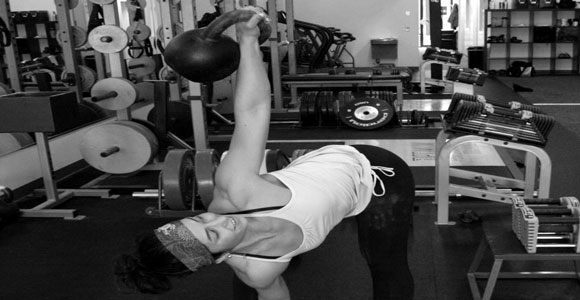1. Do you have the proper training?
As Kettlebell training becomes more popular, there are so called "experts" popping up all over the place. It takes 10,000 hours of practice to master a subject. I've completed both the RKC II and CK-FMS certifications, built a successful group Kettlebell program and trained several individuals for their RKC certifications-and I rarely refer to myself as a personal trainer Kettlebells expert.
I have, however, learned from some pretty esteemed professionals and possess what I consider to be the top level Kettlebell credentials in the industry.
If you are going to teach people how to use kettlebells, it is imperative that you have the proper training yourself. Don't assume that just because you watched a video or have been lifting for years that you're qualified to teach others.
Do yourself and your clients a favor and seek out the proper education. The RKC is really leading the pack in this realm. The certification is based on efficient and effective movement and experience based strength principles. Attend the RKC, the HKC, or at the very least learn from some of the best within the RKC cadre.
2. Kettlebell Training has very important nuances.
This goes right along with getting the proper training with which to coach your clients. The most common mistake I see from strength coaches and personal trainers is assuming that because they know how to lift and train, they can simply figure out the Kettlebell lifts on their own. Although Kettlebell training is a fantastic approach towards achieving strength, power and overall fitness, it's not just the same strength moves you already know with a different tool.
Having a strength training background is helpful to absorbing the Kettlebell skills, but there are still specific nuances that must be applied towards Kettlebell lifts if you wish to accomplish effective and efficient training for your population. I've met talented coaches who can lift beautifully but their Kettlebell swing makes me wince.
I have also had the pleasure of presenting and teaching to some experienced and educated strength coaches (such as at Mike Boyle Strength and Conditioning) and I would say the majority of those trainers walked out of those workshops with a-ha moments and new drills that are specific to the Kettlebell.
Olympic weightlifting is not the same as the Kettlebell snatch, clean and jerk. They are similar, but entirely too different to simply take one skill and blindly apply it to the other. A barbell overhead press is not the same as the Kettlebell overhead press and the swing has a multitude of details that make it so unique. These are details that are integral to performing and coaching the best possible Kettlebell skills you and your clients can achieve.
3. It's not about the bell, it's about movement.
A few years ago, kettlebells were still relatively unheard of. "Kettlebell" has now become a buzz word, which can be both frustrating and beneficial to you as a trainer. When I tell people what I do, I'm often told something like, "Oh kettleBALLS, yeah I use those." Oy ve.
It's great that they have gained popularity, because it helps us as trainers to explain our purpose and sends more potential clients in our direction. Unfortunately we can lose sight of the fundamental principles of movement by trying to force fancy tools and exercises on clients instead of using the appropriate tool for each individual and their considerations.
Understanding movement is the foundation to any successful strength training program. If we make the training about the Kettlebell and not about teaching our clients efficient, pain free human movement, we are missing the point. In my group "Kettlebell" classes we educate the clients about basic human movement by teaching them how to push, pull, squat and deadlift. I want them to love Kettlebell training because it helps them move, feel and look better, not because it's trendy.
4. Fundamentals first, fancy stuff later (maybe).
Everyone wants to learn the snatch, but what happened to the swing? As a general rule, if I have taken the appropriate amount of time to build a client's swing technique, it doesn't take me more than a few minutes to get them snatching safely.
Too often, people want to skip all the basics and go right to the fancy stuff. They want to walk before they crawl and as we as trainers know all to well-this just doesn't work. Advanced exercises are only beneficial to advanced trainees.
For a lot of clients, this is a tough pill to swallow. They see other people doing something cool looking, like a snatch or bent press and they want to do it right away. It's our job to dial in the basics and train people within the realm of their capabilities. Not everyone will progress to double Kettlebell clean and jerks, and that's okay. It really is, I promise.
You know what they say: "The difference between the elite and everyone else, is that the elite have mastered the basics."
5. Ugly swings don't count.
Ugly swings drive me B-A-N-A-N-A-S. You see them everywhere; on TV shows, infomercials, YouTube, in catalogues and magazines and at most gyms.
Sadly, it's done wrong more than it's done right. The swing is not a squat with a front raise. Nor is it an upper body hunch followed by extreme lumbar extension. It's a deadlift or a hinge, followed by a powerful, explosive hip snap, accompanied by a rigid torso. It's graceful, aggressive and perfectly sequenced. Anything else is NOT a swing.
The main purpose of the swing is to develop HIP POWER. It can be used very effectively as a fat loss and conditioning tool, but only if it's performed correctly and efficiently. Take the time to pattern the deadlift and ensure that your client has adequate mobility, core stability and glute activation in order to move freely through the swing.
6. The Turkish Get Up is not "get up off the ground by any means necessary".
The wrist and elbow MUST be straight. The arm MUST be perpendicular to the ground. The shoulder MUST be packed. These are non-negotiable details of the get up. Just because you get off the ground, doesn't mean you did a get up.
Rushing to perform the get up with insane amounts of weight is just that-insane. Master the basics, remember? All of my clients perform tons of "naked" (weightless) get ups before they earn the right to touch a kettlebell. It's about respecting the bell and respecting movement.
http://youtu.be/TF1ULxRpp2w
7. Hand care is paramount
You've undoubtedly seen all the pictures floating around the web of torn callouses and bloody hands. Yuck. Some people will have you believe that this is an inevitable part of Kettlebell training and that's just not true. Torn up hands do not make you more hardcore, they just mean something went wrong. I've been there, and it's seriously sucks.
The good news is, callouses can be protected and clients can enjoy Kettlebell training without trashing their hands. All it takes is a little proactivity and maintenance.
8. Teeny tiny bells are (next to) useless.
I was teaching a workshop this past weekend and there was this little 5 pound Kettlebell. It was so cute. And useless.
Heavy is a relative term, and the number on the bell should not be the only thing that denotes progress. But these ridiculously small kettlebells that are being shown in certain infomercials and other media are really not going to accomplish much.
We do have 10 and 14 pound bells at our gym, and use them for teaching the get up and bottom up concepts, as well as for the more "frail" in our population when performing overhead movements. Outside of that, anything under 18 pounds is downright silly. Even 18 lbs is a paperweight after awhile. My client Kathy is a 62 year old grandmother who does get ups and overhead presses with 12 kg (26lbs), swings 20kg (44lbs) and goblet squats 24kg (53 lbs). She can deadlift her bodyweight and has no reason to even touch a 14 lb bell.
When purchasing kettlebells, save your money and go with 8kg and up.
9. KB quality DOES matter...to an extent.
Speaking of purchasing kettlebells, this can be a tough decision and one that becomes even more difficult as the market grows.
I've used tons of bells from various manufacturers, and I can tell you this: I'm a Kettlebell snob. The quality of your bell DOES matter and can affect your training, especially with regard to overhead movements and hand care. Outside of those two important considerations, it's not that important which brand you go with, although some of the cheaper brands don't always weigh what they say they do.
10. KB training gives your clients fun, new goals.
Kettlebell training will get your clients excited about Kettlebell specific goals that will help progress their movement, strength, power and conditioning. They will start wondering how much can I swing? Press? TGU? (All with good form of course!). And what about snatch tests? Double Kettlebell work? Complexes? Maybe they'll want to get better at the basics so they can learn to clean and jerk, or improve their mobility so they can try their hand at windmills.
All of these training goals will get them closer to the best possible version of themselves, while continuing to align flawlessly with solid strength and conditioning principles. I know that for me, even though I was well versed in compound lifts and played around with Oly lifts, Kettlebell training took me to the next level. It made things more fun and inspired me to aspire to new heights without compromising my training principles.
If implemented intelligently, Kettlebell training can be an extremely beneficial venture for you and your clients.










